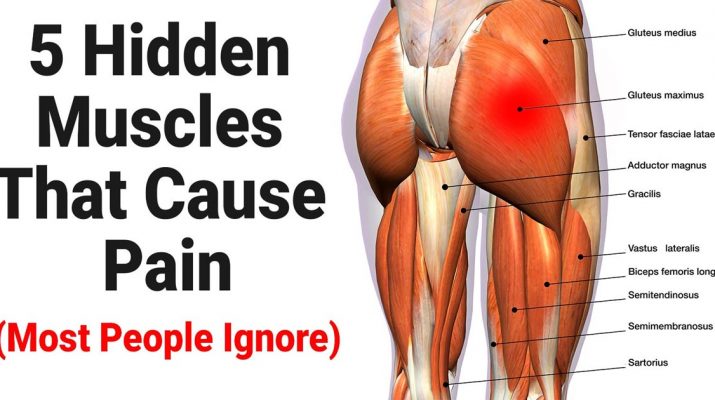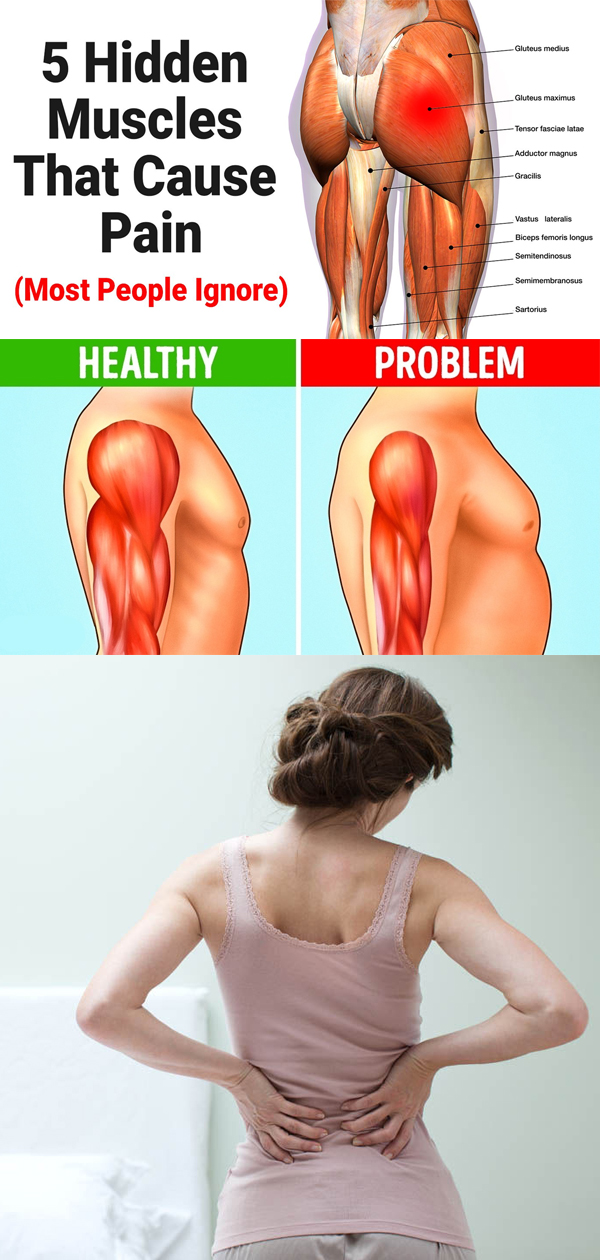Major muscle groups get most of the attention – especially at the gym and in front of the mirror! But our smaller muscles carry a lot of the weight (literally) and perform many vital functions. Medical doctors and other specialists also know that malfunctioning of a number of small muscles can cause a whole bunch of pain and other problems.
Pain management clinics, for example, are busy 24/7 trying to figure out exactly what muscle is causing Patient “A” to be in so much agony. Pain management doctors x-ray, scan, laser beam, and do just about everything else to figure out the problem. Too often the problem is some small, “insignificant” muscle.
In this article, we’re going to discuss the role and functions of various muscle tissues. We’ll talk about which muscles are responsible for back, neck, shoulder, foot, and butt pain. Finally, we’ll give some pointers to (hopefully) prevent muscle pain from surfacing. Let’s do this!
“Minor muscles enable large muscles to do their job. When the small ones aren’t working properly, it can lead to injury or pain.” – Bryan Heiderscheit, Ph.D.
Muscles: What Are They, Really?
There are an estimated 700 skeletal muscles in the human body that are classifiable into three groups: skeletal, cardiac, and smooth muscles. Skeletal muscles allow movement and give us ability; cardiac muscles expand and contract the heart and transport blood throughout the body. Smooth muscles are those of organs and do the little things like focus our eyes and contract the bowels.
While the idea of learning about muscles may sound boring, this couldn’t be farther from the truth. Muscles are as fascinating as they are complex. Consider these factoids:
- The gluteus maximus is the largest muscle in the human body. (Yay, butts!)
- The muscles of the middle ear are the smallest.
- Taking one step requires the movement of 200 muscles.
- The strongest muscle is located in the jaw and is used for chewing.
- The heart muscle is the only muscle that never tires.
- Your fingers do not have any muscles – just bones.
- Smiling requires 17 muscles. It takes 43 to frown.
- The spine contains over 120 muscles.
- Your eye muscles move a whopping 100,000 times per day!
- “Muscle memory” is a term used to describe movements that the muscles become accustomed to over time.
- Why do you shiver when it’s cold? Because low temperatures cause involuntary contraction of the muscles.
- We use the muscles of our eyelids to blink more than 16,000 times a day!
- Muscles constitute 40 percent of our total body weight; just 10 percent less than water!
Muscle Types
Skeletal muscles are attached to bones. Contraction of these muscles is what permits us to move. Examples of skeletal muscle movement include walking, chewing, and stretching.
Smooth muscle (or visceral muscle) makes up the tissue of our internal organs. Smooth muscle is entirely involuntary and is the “weakest” type of muscle. Important functions of smooth muscles include expansion and contraction of the heart and the bowels. A healthy circulatory system is dependent upon smooth muscle movement.
Cardiac muscle, as the name implies, is located exclusively in the heart. Cardiac muscle is also involuntary and contracts to form our heartbeat. The autonomic nervous system controls the heart rate.
Functions Of Muscles
According to experts, there are 10 main functions of the muscular system:
-
Movement
Of course, the primary purpose of the muscular system is to permit movement. There exist two varieties of movement, gross and fine. Gross movements are things like running, swimming, and walking. Fine movements include facial expressions, speaking, and writing.
-
Stability
Muscle tendons and core muscles help to stabilize the body. Core muscles can be found in the abdomen, back, and pelvis. Tendons of the joints, knees, and shoulders also provide stabilization.
-
Posture
Muscles of the skeletal system help us remain upright when necessary. Flexible, durable muscles permit good posture.
-
Circulation
As mentioned, the heart muscle pumps blood throughout the body. Smooth muscles of the arteries and veins further assist blood circulation.
-
Respiration
Diaphragmatic muscles permit expansion and contraction of the lungs. Deep breathing uses muscles of the abdomen, back, and neck.
-
Digestion
Smooth muscles line the entire gastrointestinal tract, from the mouth to the anus. Peristalsis comprises the wave-like movements of these smooth muscles.
-
Urination
Our urinary system contains both smooth and skeletal muscles, including in the bladder, kidneys, penis or vagina, prostate, ureters, and urethra.
-
Vision
Skeletal muscles around the eye sockets allow eye movement. These muscles assist in stabilization, scanning, and tracking.
-
Organ Protection
Besides the smooth muscles which comprise the outer layers of the major organs, skeletal muscles of the ribs, spine, and torso also provide protection.
-
Temperature Regulation
Nearly 85 percent of all heat generated by the body is caused by muscle contraction. The skeletal muscles also help to create body heat when necessary.
5 “Hidden” Muscles That May Cause Pain
-
Multifidus: Back Pain
The multifidus is a series of small, triangular-shaped muscles that help to support the spine. These thin muscles help to stabilize, flex, and extend the vertebral column – a sequence of 33 vertebrae that runs from the pelvic floor all the way to the base of the skull!
Multifidi pain usually originates in the lower back but may extend upwards. Preventing pain in this area may be as simple as making sure to take some time to stand up, stretch, and walk from time to time, especially if you sit often.
-
Scalenus: Neck Pain
The scalene is a group of three muscles that line the side of the neck. The primary functions of the anteriorand middle scalene muscles are to flex and bend the neck and elevate the first rib. The posterior scalene muscle lifts the second rib and flexes and bends the neck.
If you’ve ever woken up with that lovely stiff neck pain, you’ve probably irritated the scalene muscles. When this happens, you need to locate your scalene trigger points. To do so, place the tips of your right hand’s fingers alone the left side of your neck. Put slight pressure on each point and repeat 10 times on both sides.
-
Supraspinatus: Shoulder Pain
The supraspinatus is the smallest of four muscles which make up the rotator cuff. The muscle works to prevent damage of the shoulder originating from gravitational forces. The supraspinatus works – individually and with the deltoid muscle – to rotate the shoulder joint and arm.
To avoid damage of the muscle, avoid repetitive overhead movement of the arm, particularly if doing so causes pain, however minimal. Practicing good posture and engaging in shoulder-blade exercises may also help.
-
Piriformis: Butt Pain
The piriformis is a flat muscle located in the deep gluteal muscles. It has a pyramid-like shape that stretched from near the hip joint to the pelvis. The muscle rotates the hip when standing and abducts the hip at rest.
Stretching and strengthening the piriformis muscle is a priority for athletes and the physically active. You can stretch the piriformis by lying flat on your back and crossing the left foot across the right knee at the ankle. Interlocking your fingers underneath and just below the right knee, lift the right foot off the ground until it is parallel with your abdomen, then switch legs.
-
Hallucis Longus: Foot Pain
The hallucis longus is the muscle that enables you to curl your big toe. How could it cause foot pain? Well, the big toe is crucial for both balance and stabilization when we’re upright. When this muscle is damaged, extra strain is put on the rest of the foot, which often causes pain.
Doing exercises such as body lunges and body squats while barefoot can help strengthen the hallucis longus, along with other muscles of the foot. Furthermore, such exercises train balance and are good for helping maintain skeletal and muscular alignment. Also make sure to purchase shoes that properly fit, especially if you are on your feet often. When purchasing shoes, patron a professional store such as those that sell running shoes. A properly-trained professional can ensure that the shoe is compatible with the shape of your foot.
Final Thoughts: Maintaining Healthy Muscles
Proper diet and regular exercise are the two best ways to prevent muscle pain. Here’s how to do both:
Exercise
The only way to strengthen your muscles is to exercise. Proper exercise helps you grow muscle tissue, which helps to prevent injury. Per the National Institute of Arthritis and Musculoskeletal and Skin Diseases, some of the best types of activities include climbing stairs, dancing, jogging, lifting weights, playing tennis, swimming, biking, and running. The optimal amount of physical activity is 60 minutes per day.
A Balanced Diet
A proper diet is crucial for delivering needed nutrients to your muscles. Eat a diet rich in fruit, vegetables, and lean protein. Avoid trans fats and drink at least 64 ounces of water per day. Iron is a critical nutrient that is required for muscle health. Good sources of iron include lean meat, poultry, beans, peas, and spinach.


